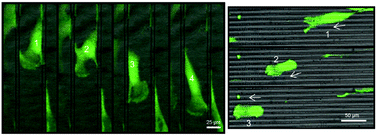Microfabricated mimics of in vivo structural cues for the study of guided tumor cell migration†
Abstract
Guided cell migration plays a crucial role in tumor metastasis, which is considered to be the major cause of death in cancer patients. Such behavior is regulated in part by micro/nanoscale topographical cues present in the parenchyma or stroma in the form of fiber-like and/or conduit-like structures (e.g., white matter tracts, blood/lymphatic vessels, subpial and subperitoneal spaces). In this paper we used


 Please wait while we load your content...
Please wait while we load your content...